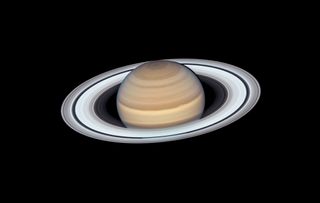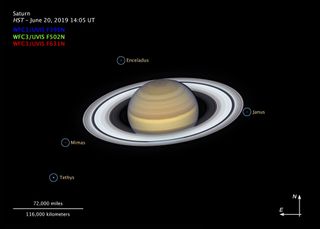Saturn and Its Rings Look Truly Spectacular in This Hubble Telescope Portrait
The rings of Saturn can be an awesome sight through a telescope, and when you've got the most iconic space telescope at your disposal, the view is absolutely jaw-dropping. Case in point: this amazing new view from the Hubble Space Telescope.
NASA and the European Space Agency unveiled the new Saturn portrait today (Sept. 12). The image was taken on June 20 by Hubble's Wide Field Camera 3 as Saturn was about 845 million miles (1.36 billion kilometers) away.
It's the second in a series of annual photos for the Outer Planets Legacy project by scientists studying the gas giant planets of our solar system. "In Saturn's case, scientists are tracking weather patterns and other changes to identify trends," NASA and ESA officials said in an image description.
Video: Watch Saturn's Moons Dance in Amazing Hubble View
Related: Amazing Photos of Saturn's Glorious Rings

That science is all well and good, but to the casual viewer, it's the beauty of Saturn that reigns supreme in the new image.
"Saturn hosts many recognizable features, most notably its trademark ring system, which is now tilted towards Earth," NASA/ESA officials wrote in the image description. "This gives us a magnificent view of its bright icy structure."
And then, there's Saturn's bizarre hexagon, a target of truly perplexing geometry. The weird hexagon-shaped phenomenon encircles Saturn's north pole and was first spotted by NASA's Cassini spacecraft in 2007. Cassini orbited Saturn from 2004 to 2017.
Get the Space.com Newsletter
Breaking space news, the latest updates on rocket launches, skywatching events and more!
"It is a mysterious six-sided pattern caused by a high-speed jet stream," NASA/ESA officials added. "The hexagon is so large that four Earths could fit inside its boundaries (there is no similar structure at Saturn's south pole)."
Photos: Saturn's Bizarre Hexagon Up Close
Four of Saturn's moons (which number 62 in all) are visible in the new Hubble portrait. Among them is Mimas, the "Death Star" moon — so called because its massive Herschel crater gives it a look akin to the fictional moonlike space station from "Star Wars."
The other Saturnian moons spotted by Hubble are icy Enceladus, which harbors geysers and a vast water ocean under an icy shell; Janus, a potato-shaped moon covered in craters; and Tethys, an icy round moon with weird red arcs of material on its surface.
Finally, there's Saturn itself, which shines like a ruddy jewel in the black of space.
"Saturn's amber colors come from summer smog-like hazes, produced in photochemical reactions driven by solar ultraviolet radiation," NASA/ESA officials said. "Below the haze lie clouds of ammonia ice crystals, as well as deeper, unseen lower-level clouds of ammonium hydrosulphide and water."

Saturn's atmosphere gets its banded look from winds and clouds moving at different altitudes.
The Hubble Space Telescope launched in 1990 and is one of the most prolific space observatories of all time. The orbiting telescope typically gazes into the deepest expanses of space to make cosmic discoveries, but its camera eye can reveal surprising details about planets closer to home.
"Hubble's high-resolution images of our planetary neighbors can only be surpassed by pictures taken from spacecraft that actually visit these bodies," 'NASA/ESA officials wrote. "However, Hubble has one advantage over space probes; it can look at these objects periodically and observe them over much longer periods than any passing probe could."
- Cassini's Death Dive into Saturn Reveals Weird Ring 'Rain' & Other Surprises
- Saturn's Moon Titan May Have 'Phantom Lakes' and Caves
- In Photos: Cassini Mission Ends with Epic Dive into Saturn
Email Tariq Malik at tmalik@space.com or follow him @tariqjmalik. Follow us @Spacedotcom and Facebook
Join our Space Forums to keep talking space on the latest missions, night sky and more! And if you have a news tip, correction or comment, let us know at: community@space.com.

Tariq is the Editor-in-Chief of Space.com and joined the team in 2001, first as an intern and staff writer, and later as an editor. He covers human spaceflight, exploration and space science, as well as skywatching and entertainment. He became Space.com's Managing Editor in 2009 and Editor-in-Chief in 2019. Before joining Space.com, Tariq was a staff reporter for The Los Angeles Times covering education and city beats in La Habra, Fullerton and Huntington Beach. In October 2022, Tariq received the Harry Kolcum Award for excellence in space reporting from the National Space Club Florida Committee. He is also an Eagle Scout (yes, he has the Space Exploration merit badge) and went to Space Camp four times as a kid and a fifth time as an adult. He has journalism degrees from the University of Southern California and New York University. You can find Tariq at Space.com and as the co-host to the This Week In Space podcast with space historian Rod Pyle on the TWiT network. To see his latest project, you can follow Tariq on Twitter @tariqjmalik.